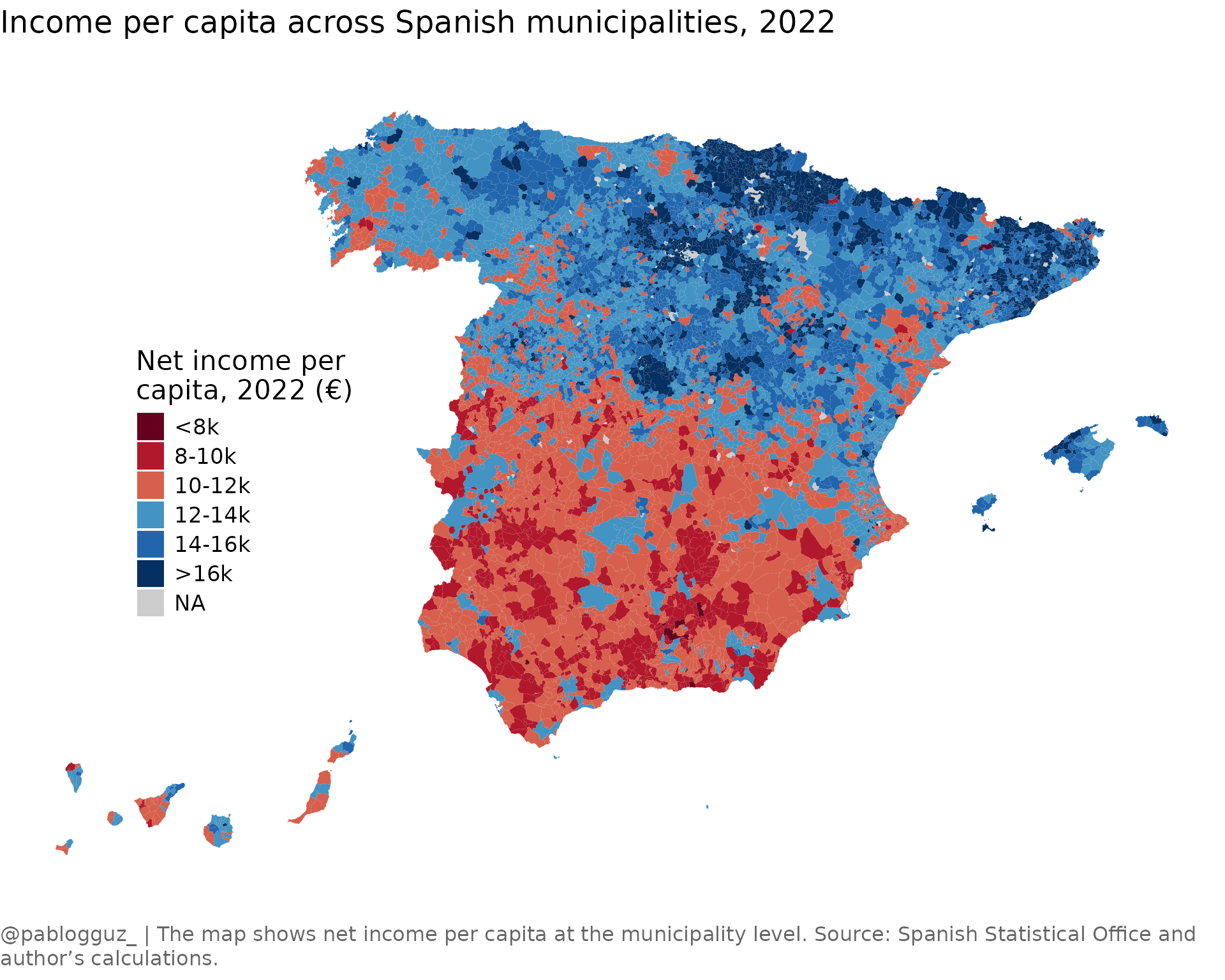
Creating maps with ineAtlas
Pablo Garcia Guzman
2025-10-22
Source:vignettes/mapping-with-ineatlas.Rmd
mapping-with-ineatlas.RmdThis vignette demonstrates how to use ineAtlas to create
choropleth maps of socioeconomic indicators across Spanish
municipalities.
Load required packages
First, let’s load the required packages. We will use the mapSpain
package to get the municipality geometries.
Get municipality data
Let’s fetch income data for all Spanish municipalities for the year 2022:
# Get municipality level income data
mun_data <- get_atlas(
category = "income",
level = "municipality"
) %>%
filter(year == 2022)
# Preview the data
head(mun_data)
#> # A tibble: 6 × 11
#> mun_code mun_name prov_code prov_name year net_income_pc net_income_hh
#> <chr> <chr> <chr> <chr> <dbl> <dbl> <dbl>
#> 1 01001 Alegría-Dulant… 01 Araba/Ál… 2022 15116 38507
#> 2 01002 Amurrio 01 Araba/Ál… 2022 16011 39221
#> 3 01003 Aramaio 01 Araba/Ál… 2022 20201 51737
#> 4 01004 Artziniega 01 Araba/Ál… 2022 15651 38089
#> 5 01006 Armiñón 01 Araba/Ál… 2022 15755 36433
#> 6 01008 Arratzua-Ubarr… 01 Araba/Ál… 2022 22484 58424
#> # ℹ 4 more variables: net_income_equiv <dbl>, median_income_equiv <dbl>,
#> # gross_income_pc <dbl>, gross_income_hh <dbl>Get municipality geometries
Now we’ll get the municipality geometries from
mapSpain:
# Get municipality geometries
mun_map <- esp_get_munic_siane() %>%
# Join with our income data
left_join(
mun_data,
by = c("LAU_CODE" = "mun_code")
)
# Preview the joined data
glimpse(mun_map)
#> Rows: 8,213
#> Columns: 18
#> $ codauto <chr> "01", "01", "01", "01", "01", "01", "01", "01", "0…
#> $ ine.ccaa.name <chr> "Andalucía", "Andalucía", "Andalucía", "Andalucía"…
#> $ cpro <chr> "04", "04", "04", "04", "04", "04", "04", "04", "0…
#> $ ine.prov.name <chr> "Almería", "Almería", "Almería", "Almería", "Almer…
#> $ cmun <chr> "001", "002", "003", "004", "005", "006", "007", "…
#> $ name <chr> "Abla", "Abrucena", "Adra", "Albanchez", "Albolodu…
#> $ LAU_CODE <chr> "04001", "04002", "04003", "04004", "04005", "0400…
#> $ mun_name <chr> "Abla", "Abrucena", "Adra", "Albanchez", "Albolodu…
#> $ prov_code <chr> "04", "04", "04", "04", "04", "04", "04", "04", "0…
#> $ prov_name <chr> "Almería", "Almería", "Almería", "Almería", "Almer…
#> $ year <dbl> 2022, 2022, 2022, 2022, 2022, 2022, 2022, 2022, 20…
#> $ net_income_pc <dbl> 11635, 10927, 9316, 10464, 11054, 9761, 10103, 120…
#> $ net_income_hh <dbl> 25522, 22066, 25639, 21030, 23237, 26991, 19494, 2…
#> $ net_income_equiv <dbl> 16511, 15129, 14206, 14958, 15436, 15267, 13757, 1…
#> $ median_income_equiv <dbl> 15050, 13650, 12950, 13650, 14350, 13650, 12250, 1…
#> $ gross_income_pc <dbl> 13305, 12361, 10650, 11885, 12457, 11545, 11311, 1…
#> $ gross_income_hh <dbl> 29187, 24962, 29311, 23885, 26187, 31924, 21823, 3…
#> $ geom <MULTIPOLYGON [°]> MULTIPOLYGON (((-2.759034 3..., MULTI…Create a choropleth map
Let’s create a map showing net income per capita across Spanish municipalities:
# Create the map
ggplot(mun_map) +
geom_sf(
aes(fill = cut(net_income_pc,
breaks = c(-Inf, 8000, 10000, 12000, 14000, 16000, Inf),
labels = c("<8k", "8-10k", "10-12k", "12-14k", "14-16k", ">16k")
)),
color = NA
) +
labs(
title = "Income per capita across Spanish municipalities, 2022",
caption = "@pablogguz_ | The map shows net income per capita at the municipality level. Source: Spanish Statistical Office and author's calculations."
) +
scale_fill_manual(
name = "Net income per \ncapita, 2022 (€)",
values = c("#67001F", "#B2182B", "#D6604D", "#4393C3", "#2166AC", "#053061"),
na.value = "grey80"
) +
theme_void() +
theme(
text = element_text(family = "Open Sans", size = 16),
plot.title = element_text(size = 18, margin = margin(b = 20)),
legend.position = c(0.2, 0.5),
plot.caption = element_textbox_simple(
size = 12,
color = "grey40",
margin = margin(t = 20),
hjust = 0,
halign = 0,
lineheight = 1.2
)
)
Identifying high and low income areas
Let’s find the top 10 municipalities by net income per capita:
mun_data %>%
arrange(desc(net_income_pc)) %>%
select(mun_name, net_income_pc) %>%
head(10) %>%
mutate(
net_income_pc = round(net_income_pc, 2)
)
#> # A tibble: 10 × 2
#> mun_name net_income_pc
#> <chr> <dbl>
#> 1 Pozuelo de Alarcón 29258
#> 2 Oroz-Betelu/Orotz-Betelu 25780
#> 3 Goñi 25532
#> 4 Matadepera 24814
#> 5 Bolvir 24812
#> 6 Boadilla del Monte 24748
#> 7 Palau de Santa Eulàlia 24437
#> 8 Madremanya 24190
#> 9 Vilamòs 24052
#> 10 Brull, El 23957And the bottom 10:
mun_data %>%
arrange(net_income_pc) %>%
select(mun_name, net_income_pc) %>%
head(10) %>%
mutate(
net_income_pc = round(net_income_pc, 2)
)
#> # A tibble: 10 × 2
#> mun_name net_income_pc
#> <chr> <dbl>
#> 1 Odèn 6274
#> 2 Torre del Burgo 6277
#> 3 Manjarrés 7146
#> 4 Huesa 7603
#> 5 Darro 7712
#> 6 Guadahortuna 7757
#> 7 Iznalloz 7777
#> 8 Palmar de Troya, El 7779
#> 9 Albuñol 7949
#> 10 Palomas 8036